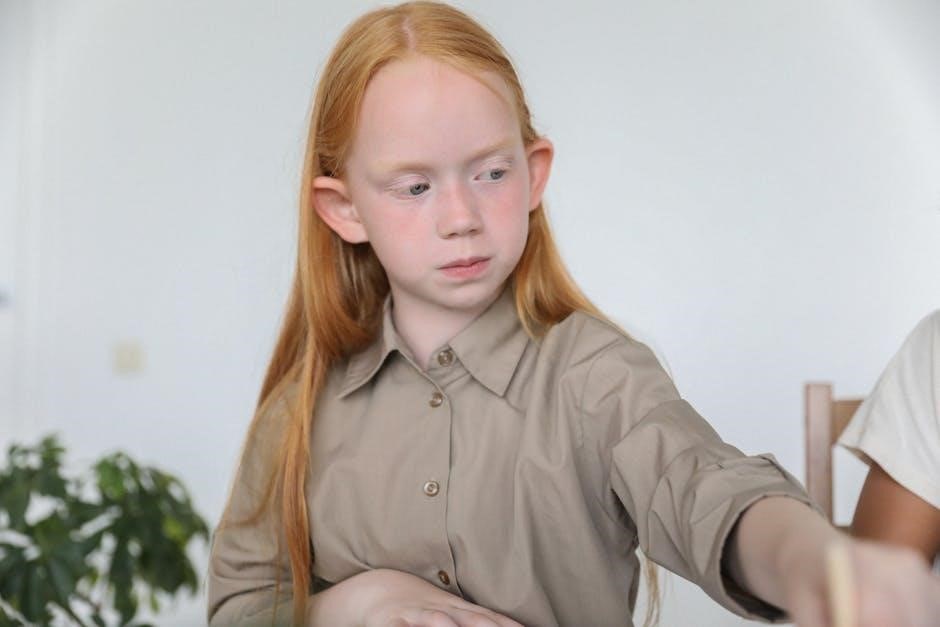Discover the versatility of Art Lesson Plans PDFs, offering structured guidance for educators to inspire creativity and learning in the classroom. Perfect for teachers seeking organized, engaging resources.
What Are Art Lesson Plans PDF?
Art Lesson Plans PDFs are digital documents designed to guide educators in delivering structured art education. They typically include detailed outlines of lessons, activities, and projects tailored for specific age groups or skill levels. These PDFs often feature clear objectives, materials lists, and step-by-step instructions to help teachers facilitate engaging and meaningful art experiences. Many are created by experienced educators or educational organizations, ensuring high-quality content. They cover a wide range of artistic mediums, from drawing and painting to digital art and interdisciplinary projects. The PDF format makes them easy to share, print, and adapt, offering flexibility for classrooms of all sizes and settings. This resource is invaluable for teachers seeking organized, creative, and effective art instruction.
Why Use Art Lesson Plans in PDF Format?
Art Lesson Plans in PDF format are favored for their convenience and accessibility. They can be easily downloaded, shared, and printed, making them ideal for teachers with limited resources or time. The PDF format ensures that the content remains consistent across different devices, preserving the layout and design. This is particularly important for visual subjects like art, where clarity and structure are key. Additionally, PDFs are eco-friendly, reducing the need for paper-based materials. They also offer flexibility, allowing teachers to customize and adapt the plans to suit their classroom needs. Overall, PDF art lesson plans provide a practical and efficient solution for delivering high-quality art education.

Benefits of Art Lesson Plans PDF
Art Lesson Plans PDF offer flexibility, cost-effectiveness, and eco-friendliness. They inspire creativity, are easy to share, and provide structured learning experiences for students of all ages.
Flexibility and Accessibility
Art Lesson Plans PDF are highly flexible, allowing teachers to adapt content to suit various classroom needs and student skill levels. They can be easily accessed on digital devices, making them convenient for remote or in-person teaching. PDFs are also simple to edit and customize, ensuring lesson plans remain relevant and engaging. Their accessibility is further enhanced by the ability to share files instantly via email or cloud platforms, making collaboration among educators seamless. Additionally, PDFs are universally compatible across devices, ensuring that teachers can prepare and deliver lessons without technical limitations. This adaptability makes Art Lesson Plans PDF an invaluable resource for modern educators seeking efficient and versatile teaching tools.
Cost-Effective and Environmentally Friendly
Art Lesson Plans PDF are a budget-friendly option for educators, eliminating the need for expensive textbooks or printed materials. Many resources are free or low-cost, reducing financial burdens on schools and teachers. Additionally, PDFs minimize paper usage, supporting environmental sustainability by reducing waste. Digital storage allows multiple lesson plans to be kept in a single file, saving physical space. This eco-conscious approach aligns with modern educational goals of reducing carbon footprints. By transitioning to digital formats, schools can allocate resources more efficiently while promoting greener practices. This makes Art Lesson Plans PDF a practical and responsible choice for educational institutions worldwide.
Easy to Share and Collaborate
Art Lesson Plans PDF are highly shareable, making it simple for educators to distribute resources to colleagues, students, or parents. They can be easily attached to emails, uploaded to cloud storage, or shared via learning management systems. This digital format allows for seamless collaboration among teachers, enabling them to review, edit, and provide feedback on lesson plans in real time. Additionally, PDFs can be stored in centralized locations, ensuring everyone has access to the most up-to-date versions. This ease of sharing fosters teamwork and consistency, while also reducing redundant work. It’s a convenient way to collaborate and ensure all stakeholders are aligned with the curriculum goals and activities.

Popular Resources for Art Lesson Plans PDF
Explore top resources for Art Lesson Plans PDFs, including free downloads from educational websites, premium subscriptions, and open-source repositories. Find diverse, grade-specific materials easily online.

Free Art Lesson Plans from Educational Websites
Many educational websites offer free downloadable Art Lesson Plans in PDF format, designed for various grade levels and artistic disciplines. These resources are created by experienced educators and organizations to support teachers in delivering engaging and structured art classes. Popular platforms like Blick and the Chicago Public Schools Department of Arts Education provide comprehensive lesson plans that include objectives, materials, and step-by-step instructions. These plans often focus on specific techniques, such as drawing, painting, or sculpture, and are aligned with educational standards. Additionally, websites like ArtIsFun and ArtsEdge offer free PDF lesson plans inspired by famous artists and cultural movements, making it easy for teachers to integrate art history into their curriculum. These resources are ideal for educators seeking cost-effective and high-quality materials to inspire creativity in their students.
Premium Art Lesson Plans from Subscription Services
Premium art lesson plans from subscription services offer high-quality, exclusive content tailored for educators. Platforms like PlanbookEdu and Teachers Pay Teachers provide detailed PDF lesson plans designed by expert educators. These plans often include advanced features such as customizable templates, multimedia integration, and aligned educational standards. Subscription-based services ensure access to regularly updated resources, catering to diverse grade levels and artistic disciplines. They also offer tools for tracking student progress and adapting lessons to meet individual needs. For educators seeking comprehensive and professional-grade materials, premium subscription services deliver unparalleled value, enhancing teaching efficiency and student engagement in art education.
Open-Source Art Lesson Plan Repositories
Open-source art lesson plan repositories provide free and accessible resources for educators. Platforms like GitHub, Google Drive, and educational forums host a wide range of downloadable PDF lesson plans. These repositories often include contributions from experienced teachers and art educators, offering diverse project ideas and curricula. Many open-source resources are tailored for specific grade levels, from elementary to high school, and cover various artistic mediums. They encourage collaboration and adaptation, allowing teachers to modify plans to suit their classroom needs. These repositories are invaluable for educators seeking cost-effective and adaptable materials to enrich their art education programs. They also foster a sense of community by sharing knowledge and creative approaches freely.

How to Create Effective Art Lesson Plans in PDF
Use templates and tools to design clear, engaging PDF lesson plans. Include objectives, materials, and step-by-step instructions. Add visuals and align with educational standards for better student engagement.
Key Elements of a Good Art Lesson Plan
A well-structured art lesson plan PDF should include clear objectives, materials lists, and step-by-step instructions. Incorporate visuals and examples to enhance understanding. Align activities with educational standards and age-appropriate skills. Assessment criteria and differentiation strategies ensure inclusivity and measurable outcomes. Use templates or design tools like Canva or Adobe for a professional layout. Ensure the PDF is interactive with links or multimedia for enriched learning experiences. Regularly update content to reflect current trends and student needs. By organizing these elements thoughtfully, educators create engaging and effective art lesson plans that foster creativity and skill development.
Tools for Designing and Converting to PDF
Popular tools for creating and converting art lesson plans to PDF include Canva, Adobe Illustrator, and Google Docs. Canva offers templates for visually appealing designs, while Adobe Illustrator provides advanced customization options. Google Docs is ideal for basic layouts and collaboration. For conversion, tools like Smallpdf, ILovePDF, and PDFCrowd enable seamless transformation of Word or PowerPoint files into PDFs. These tools ensure professional-quality output, making lesson plans easy to share and print. Many platforms also support interactive elements, enhancing the learning experience. By leveraging these tools, educators can efficiently design and distribute engaging art lesson plans in PDF format, catering to diverse teaching needs and preferences.
Best Practices for Formatting and Layout
When designing art lesson plans in PDF format, clarity and readability are key. Use clear, legible fonts such as Arial or Times New Roman, and ensure adequate spacing between sections. Incorporate headings and subheadings to organize content logically, making it easy to navigate. Include visuals like images, diagrams, or illustrations to enhance understanding and engagement. Utilize bullet points or checklists for step-by-step instructions, and highlight important details with bold text or color. Maintain consistency in formatting throughout the document, such as uniform margins and alignment. Add page numbers and a table of contents for easy navigation. Finally, proofread the document to eliminate errors and ensure a professional presentation. These practices ensure your PDF art lesson plans are both functional and visually appealing.

Art Lesson Plans PDF for Different Grade Levels
Explore tailored PDF art lesson plans designed for elementary, middle, and high school students, catering to diverse skill levels and developmental needs creatively and effectively.
Elementary School Art Lesson Plans

Elementary school art lesson plans in PDF format are designed to foster creativity and foundational art skills in young students. These plans often focus on simple, engaging activities that require minimal preparation and materials. Many resources include line art, color exploration, and craft projects tailored for grades K-5. Teachers can find printable PDFs that align with curriculum standards, ensuring a structured yet fun learning experience. Topics like self-portraits, museum visits, and basic techniques are common. These plans also incorporate classroom management tips and assessment strategies, making them ideal for educators seeking to inspire young artists while meeting educational goals. They are perfect for introducing art concepts in an accessible and enjoyable way.
Middle School Art Lesson Plans
Middle school art lesson plans in PDF format are tailored to students in grades 6-8, focusing on developing intermediate art skills and fostering creativity. These plans often include projects inspired by renowned artists, such as Kandinsky, to explore abstract concepts and techniques. Resources may cover topics like color theory, mixed media, and cultural art studies. Many PDFs are designed for easy implementation, with step-by-step instructions and materials lists. They also encourage critical thinking and self-expression, preparing students for more advanced art studies in high school. Additionally, these plans often integrate interdisciplinary elements, such as art history or science, to enhance learning. They are ideal for educators seeking to challenge and inspire middle school students while aligning with educational standards.
High School Art Lesson Plans

High school art lesson plans in PDF format cater to students in grades 9-12, focusing on advanced art techniques and in-depth creative exploration. These plans often include projects inspired by professional artists, such as Pirkle Jones, to analyze and replicate artistic styles. Topics may range from advanced drawing and painting to digital art and sculpture. PDF resources provide detailed instructions, materials lists, and alignment with high school art standards. They emphasize critical thinking, artistic interpretation, and portfolio development. Many plans integrate art history and cultural context to enrich learning. Educators can use these PDFs to challenge high school students, preparing them for advanced art studies or careers in creative fields. Additionally, they offer flexibility to adapt to diverse classroom needs.

Integrating Art with Other Subjects in PDF Lesson Plans
Art lesson plans in PDF format seamlessly integrate with subjects like science, math, and language arts, fostering interdisciplinary learning. This approach enriches creative and academic experiences for students.
Arts Integration in Science and Math
Integrating art into science and math lessons enhances understanding and engagement. For instance, students can visualize scientific concepts like light refraction or cellular structures through artistic interpretations. Similarly, math principles, such as geometry and symmetry, can be explored creatively, fostering a deeper connection to abstract ideas. Art lesson plans in PDF format often include activities that bridge these subjects, making complex concepts more accessible and fun for learners of all ages.
By combining art with science and math, educators create a holistic learning experience. Students develop critical thinking and problem-solving skills while expressing their creativity. This interdisciplinary approach not only enriches academic understanding but also encourages innovation and collaboration in the classroom.
Using Art in Language Arts and History
Art lesson plans in PDF format often incorporate activities that bridge language arts and history, fostering a deeper understanding of texts and historical contexts. Students can analyze and interpret artworks inspired by literary works or historical events, enhancing their critical thinking skills. For example, creating illustrations for a novel or designing historical murals encourages students to visually represent their understanding of themes and narratives.
These PDF plans also provide structured exercises for integrating art into language arts and history curricula. By aligning creative projects with educational standards, teachers can help students develop a more nuanced appreciation of both subjects while fostering creativity and collaboration in the classroom.
Interdisciplinary Art Projects and Activities
Interdisciplinary art projects in PDF lesson plans combine multiple subjects, such as science, math, and language arts, to create holistic learning experiences. These activities encourage students to explore connections between art and other disciplines, fostering creativity and critical thinking. For instance, students might design geometric patterns in math, illustrate scientific concepts, or create historical murals, blending art with academic content. PDF lesson plans often include detailed instructions and resources, making it easier for educators to implement these projects effectively. By integrating art into various subjects, students gain a broader understanding and develop essential skills in a engaging and interactive way.
Technology and Art Lesson Plans PDF
Technology enhances art education through digital tools, software, and online platforms, offering interactive and accessible learning experiences. PDF lesson plans integrate these resources seamlessly for creative and engaging instruction.
Digital Art Tools and Software
Digital art tools and software revolutionize traditional art techniques, offering versatile creative possibilities. Procreate, Adobe Photoshop, and Canva enable students to explore digital painting, graphic design, and mixed media. These platforms provide layers, brushes, and effects, making it easy to experiment and refine work. Online platforms like PlanbookEdu and Blick for Art Education offer lesson plans integrating digital tools, ensuring modern skills are developed. Teachers can share PDFs with tutorials, fostering interactive learning. Digital art tools also promote collaboration, allowing students to work on shared projects. They enhance accessibility, making art education engaging and fun for diverse learners. This integration ensures students master both traditional and digital art forms effectively;
Online Platforms for Art Education
Online platforms for art education have transformed how teachers access and implement lesson plans. Websites like PlanbookEdu and Blick for Art Education offer extensive libraries of free and premium art lesson plans. These platforms cater to various grade levels, providing resources for elementary, middle, and high school art classes. Many platforms integrate digital tools, enabling teachers to download printable PDFs, project ideas, and activity templates. Additionally, platforms like Pinterest and specialized art education sites curate inspiring projects and lesson ideas. These resources help educators create engaging, structured lessons, fostering creativity and skill development in students. Online platforms also support interdisciplinary approaches, making it easier to integrate art with subjects like science, math, and language arts, enhancing overall educational experiences.
Interactive PDFs for Enhanced Learning
Interactive PDFs are revolutionizing art education by offering dynamic and engaging lesson plans. These PDFs often include clickable links, embedded videos, and interactive activities, making learning more immersive. Teachers can use these resources to create hands-on experiences, such as virtual museum visits or step-by-step art tutorials. Many platforms now provide interactive PDFs that cater to different learning styles, allowing students to explore art concepts at their own pace. For example, PDFs with animations or quizzes can make complex art techniques more accessible. Additionally, interactive PDFs often include printable worksheets and project templates, making them versatile tools for both classroom and remote learning environments. This innovative approach enhances student engagement and fosters creativity in art education.

Assessment and Evaluation in Art Lesson Plans PDF
Effective assessment tools in art lesson plans PDFs help evaluate student progress and creativity. Rubrics, portfolios, and feedback mechanisms ensure comprehensive and meaningful evaluation of artistic skills and understanding.
Rubrics and Assessment Criteria
Rubrics and Assessment Criteria
Art lesson plans PDFs often include detailed rubrics and assessment criteria to evaluate student performance. These tools help teachers measure creativity, technique, and understanding of artistic concepts effectively.
Clear criteria ensure consistency in grading, while rubrics provide students with specific goals and expectations. This structured approach fosters growth and helps identify areas for improvement in their artistic development.
Portfolio Development and Review
Portfolio development is a crucial aspect of art education, allowing students to showcase their creative growth and artistic achievements. Art lesson plans PDFs often include guidelines for building and reviewing portfolios, helping students reflect on their progress and set goals for improvement.
Teachers use these portfolios to assess student understanding and skill development over time. Regular reviews provide opportunities for constructive feedback, encouraging students to refine their techniques and explore new artistic expressions. Digital portfolios are increasingly popular, offering a convenient and organized way to store and share student work.
Feedback Mechanisms for Improvement
Feedback mechanisms are essential for fostering growth and refinement in art education. Art lesson plans PDFs often incorporate structured feedback tools, such as peer review guides, self-assessment checklists, and teacher evaluation criteria.
These tools enable students to reflect on their work and identify areas for improvement. Digital platforms also allow for real-time feedback, making the process more interactive and efficient. By integrating feedback mechanisms into lesson plans, educators can help students develop a growth mindset and encourage iterative learning.
Examples include using rubrics to assess artistic skills and creativity, or incorporating digital comment tools for immediate feedback on PDF assignments. This approach ensures continuous improvement and enhances the overall learning experience.
Art lesson plans in PDF format are invaluable resources for educators, offering flexibility, accessibility, and creativity in teaching. They empower teachers to deliver engaging, structured lessons effectively.
By leveraging these plans, educators can foster artistic growth, adapt to diverse learning needs, and inspire students to explore their creative potential, ensuring a lasting impact on art education.
Final Thoughts on Art Lesson Plans PDF
Art lesson plans in PDF format are a transformative resource for educators, offering unparalleled flexibility and accessibility. They provide structured yet adaptable frameworks, enabling teachers to deliver engaging and meaningful art instruction. Whether for elementary, middle, or high school, these plans cater to diverse learning needs, fostering creativity and critical thinking. Their digital format ensures easy sharing and collaboration, making them a valuable tool for modern classrooms. Additionally, PDFs are environmentally friendly, reducing the need for physical materials. As art education evolves, these plans remain a cornerstone, empowering teachers to inspire students and nurture their artistic potential effectively.
Future Trends in Art Education Resources
The future of art education resources, including PDF lesson plans, lies in integrating technology and interdisciplinary approaches. Expect increased use of digital tools, such as AI and augmented reality, to enhance creativity and engagement. Interactive PDFs with multimedia elements will become more prevalent, offering immersive learning experiences. There will also be a greater emphasis on cultural diversity and inclusivity in lesson content. Collaboration between educators worldwide will drive the development of global art education standards. Additionally, eco-friendly and accessible resources will remain a priority, ensuring art education is available to all. These trends promise to make art education more dynamic, innovative, and inclusive for future generations.
